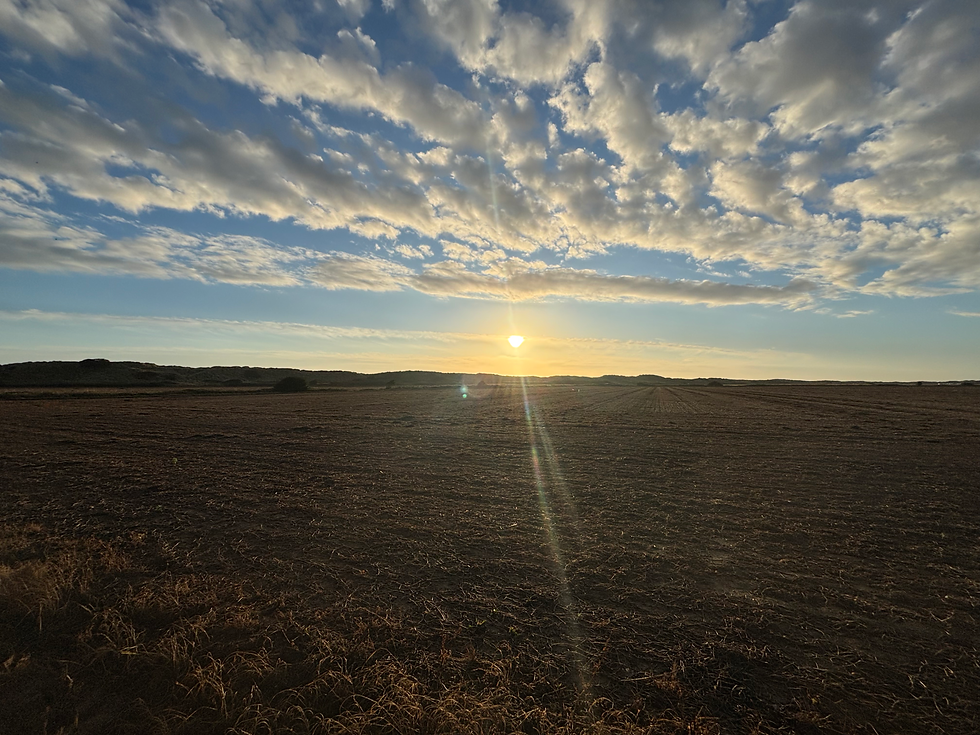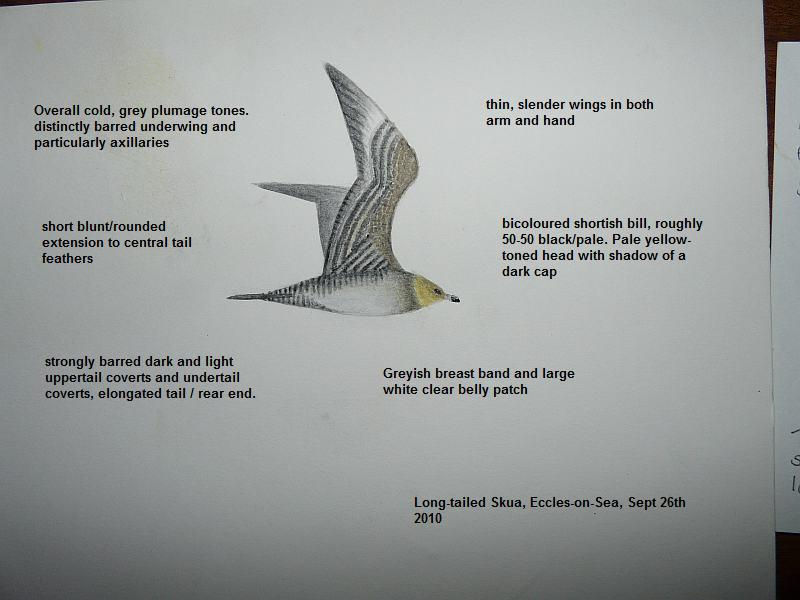Out of the Blue
- tg42lowcarbonbirding
- Aug 25
- 3 min read
Long-tailed Skua, Sea Palling, Weds Aug 20
The wind had turned northerly and it looked like a decent morning to watch the sea again. I cycled up to my seawatch site at dawn, enjoying the sunrise as I approached the dunes. It took a minute to get out of the wind but I was soon set up and marvelling at the sunbeams on show. Every morning is different.

There were bit and bobs moving within 15 minutes or so, with many Gannets going south at close range. A few wildfowl were moving north, the usual scoters and Teal. Around 0630, I got onto something coming south just beyond the reefs. Split-second initial thought was a falcon. It was moving purposefully so I wasn’t going to have too long on it. I scoped it and was immediately struck by the grey-brown tones of the bird. I quickly realised it wasn’t a falcon and that it was, in fact, a skua. As the tone of the bird clearly pointed to it being an intermediate Long-tailed, I focussed intently on getting as much detail as I could.
The bird looked powerful and strong around the front end but the rest of it just tapered away forever! It had a remarkably long-bodied appearance – as long as any Long-tailed Skua I can recall seeing. I grilled the rear end; a black tail visible beyond some black and white barring on the rump / uppertail. There was also a distinct tail protection, looking like two fingers. Again, as long as I can recall ever seeing here, perhaps due to it being an early bird lacking much wear. As the bird banked slightly, it revealed similarly grey-brown underparts with a paler area centrally. I couldn’t see any visible white primary shafts in the outerwing but some fringing on the coverts and mantle was visible. Needless to say, there was nothing warm-toned about this bird! I didn’t get a decent view of the underwing as the bird dropped quite low as it flew through. After a long period of few birds and a lot of heat, it was great to be sitting in the dunes, in a fairly strong wind, watching seabirds moving. Sadly, these birds aren’t on the County description list but I enjoy writing them and reliving the experience years later.

“Blue” Fulmar, Aug 21
A real surprise this one. I’d been watching since dawn again with a few Sooty Shearwaters going north, a few Manx and a GND that went north and then south – the only diver seen. I’d had a few Fulmars going north already – as they move north out of the sun, the white head “winks” at you from time to time depending on the attitude the bird is adopting. The birds seen so far were all as you’d expect; compact looking, blunt winged and quite stocky with grey uppers and white underparts and a prominent white head winking from time to time. I’d had a message a little earlier of a Cory’s north past Winterton but wasn’t hopeful.
Around 0815 I picked up a bird coming north, shearing. It looked quite dingy and concolourous above but it was hard to get much more. I waited for it to get closer and noticed it had paler underparts… was this the Cory’s coming? It looked too short winged and the flight seemed wrong. As it came into reasonable range I clocked that it was stocky and rounded winged with the heavy front end and short rear. It was built like a typical Fulmar. I looked at the head and it wasn’t white. It had a pale grey cast to it. The underparts had a similar pale grey wash to them. I looked at the white in the outer primaries and wasn’t all that surprised to see that it was rather less extensive and harder to see than usual. It was a Blue Fulmar! My first for several years and completely unexpected. It wasn’t a great one, only a single dark or intermediate but it was really enjoyable to see. The head was striking as it moved through as it wasn’t showing as bright white but was blended in with the upperparts. Subsequent Fulmars north confirmed just how different this bird was. Presumably it wandered down on the northerlies. There are records of blue Fulmar in late summer in Norfolk but it’s certainly an unusual occurrence. Made a change to seeing them in biting cold winds in late winter and early spring, like we used to.




Comments